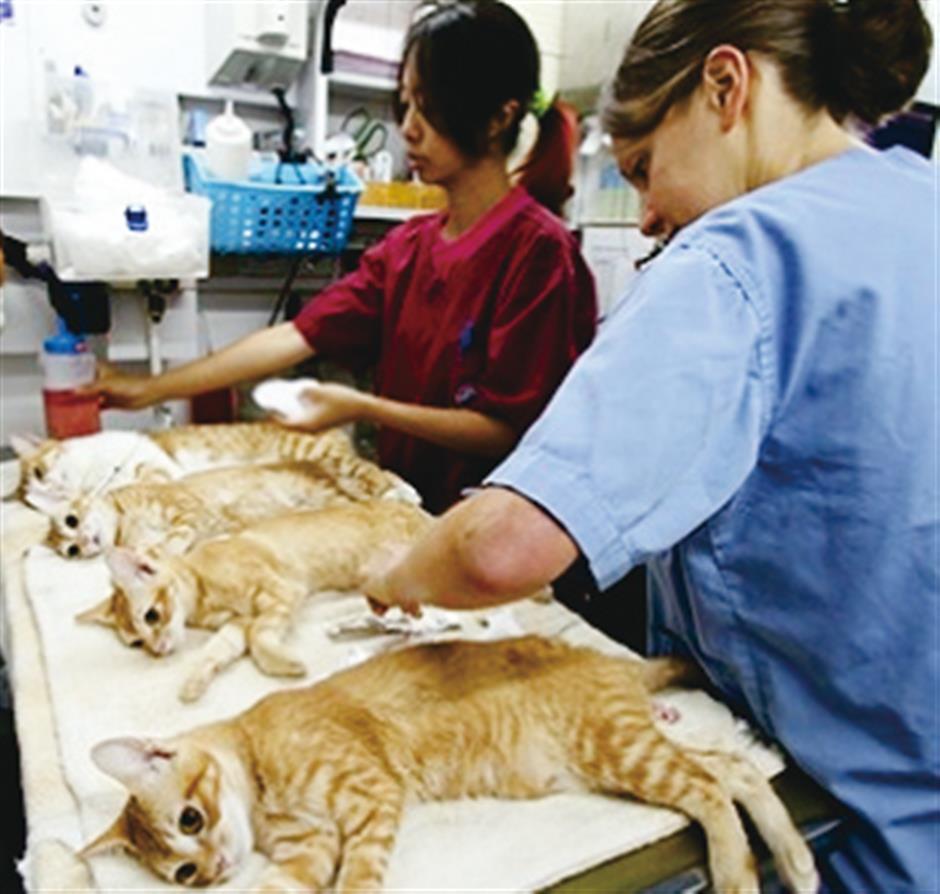Problem needing a civilized solution
The increasing number of stray animals has become a problem in China due to abandoned pets and uncontrolled breeding. What to do about them has long been the subject of debate.
There’s constantly news about stray animals, especially dogs, being put down violently by the dagoudui, or dog-killing squads. Just last month, people in Xi’an, capital of Shaanxi Province, posted online that stray dogs were being beaten to death after the city upgraded ownership restrictions. Officials denied being involved, instead blaming spontaneous action by some residents.
Though China’s pet market has reached over 170 billion yuan (US$25 billion) and people are spending a significant amount of money on pets, the notion of animal welfare still has a long way to go. Many people are unwilling to shoulder the responsibility of looking after a cat or a dog, resulting in a great number of strays.
What makes accepting strays even more difficult is that rabies still occurs across China and can kill, so stray animals are potentially hazardous.
Volunteers and non-profit organizations are rescuing and containing stray animals as best they can. At Royal Canin China’s annual forum on helping strays, experts from several animal rescue and welfare organizations spoke of their working models of animal rescue.
What should be done?
No matter where the moral compass point in viewing the stray animal situation, it’s a major problem that needs to be fixed.
An unspayed female cat, her mate and all of their offspring, producing two litters per year, with 2.8 surviving kittens per litter, can total 11,606,077 in nine years.
“The increased number of stray animals not only harms the animals’ wellbeing, but also increases conflict between human and animal,” said Wang Rundong of the Hong Kong Society for the Prevention of Cruelty to Animals (SPCA).
In some cities, stray animals are hunted down and killed. But the killing rate is far from the animal’s breeding speed, and the animals killed on the street are just a drop in the ocean.
Such brutal measures are also a torture for onlookers and are a negative influence on the next generation, said Wang. The mishandling of poisonous material and animal bodies can also harm people’s health.
“Whether people like it or not, the problem needs to be dealt with in a civilized way,” he said. The SPCA runs three programs to take care of the city’s stray animals, focusing on controlling the population through spaying and neutering.
The cat colony care program has been running for 18 years, providing free spay/neutering surgery for stray cats, giving them flea and deworming treatments, microchip implant and vaccination.
“It’s highly efficient, one veterinarian and one nurse can complete 20 to 30 surgeries a day, and they work five days a week,” said Wang. “We have over 1,000 volunteer cat care associates, and all the cats are tracked and observed.”
The program also trains volunteers to capture and take care of the cats in their zones. The program has proved efficient and effective — fewer cats on streets, a better life for the cats, more cats finding good homes, better community engagement and education.
For dogs, the SPCA has a mongrel dog and community desexing program that takes care of 2,700 dogs a year, mostly in rural areas, urban villages and construction sites. The dogs are also vaccinated and dewormed.
The SPCA also has a spay/neuter vehicle, neutering 3,500 strays per year and able to reach remote areas.
“Neutering is a relief but it can’t cure the disease, fundamentally we have to reduce the number of strays,” said Wang.
Promoting pet-keeping standards and rules, encouraging public participation as well as advocating adoption are some of the measures taken by animal rescue organizations.

The Hong Kong Society for the Prevention of Cruelty to Animals runs three programs to take care of the city’s stray animals, focusing on controlling the population through spaying and neutering.
On-campus strays
A lot of students keep pets in their dormitories, resulting in a large number of abandoned pets left on campus after they graduate.
Combined with the large number of existing feral and stray animals, on-campus animal control and rescue has become a problem.
Some schools and colleges take the easy way by killing the animals, either beating them to death or setting up poisoned bait. The inhumane, brutal killing of on-campus strays is widely criticized by students and the public, but stray animals are a danger to students, with various bite incidents reported nationwide.
Students at Shanghai Jiao Tong University have developed an animal welfare model specifically for the problem.
The SJTU Animal Care Association was established in 2015 to promote scientific animal rescue and help animals, students and faculty to live together on campus. The group is a partner with the on-campus security office and has developed a rational and efficient plan to help the strays.
Xiao Jiayi, vice captain of the association’s rescue team, said their goal was to provide immediate help to animals in need and educate students about animal welfare.
“We only conduct on-campus rescue so we can help the animals the best we can, we only save those in urgent situations and respect the laws of nature as well as the animals’ habits,” said Xiao.

Xiaohua was a case passed to the association by the campus security office. It suffered from hyperplasia of the eyelids and has been adopted after full recovery.
The association has upgraded the traditional TNR (trap-neuter-return) strategy to TNVRP — trap, neuter, vaccinate, re-turn and publicize. “There’s a good chance that the animals will remain in their territory after being neutered, they can fend off the cats and dogs entering from outside, so the population is under control,” said Xiao.
Vaccination helps reduce health risks posed by homeless animals on-campus, and the volunteers work hard to publicize the importance of spaying and neutering as well as the right ways to treat pets.
Because it requires manpower to take care of the vast number of on-campus strays, the association asks people who report animals in need to be involved in the rescue process, so they can deal with similar situations independently in future.
They also host events to engage fellow college students: Last winter they asked people to take part in building cat houses.
Though the majority of animal welfare and rescue organizations work to find new homes for the animals, SJTU Animal Care Association doesn’t focus on this aspect.
“Our audience is college students, we don’t encourage keeping pets, they should only adopt when they are capable of providing for the animals,” she said.

The SJTU Animal Care Association in Shanghai encourages fellow students in rescuing stray animals. Last winter many students took part in building cat houses.
Engage the children
Wuhan Small Animal Protection Association has created a model to connect college students with kindergarten children to promote animal welfare and educate the relationships between man and nature to establish empathy.
Du Fan, director of the association, said that through the program, students can experience what it’s like to be a teacher.
The association hosts adoption days to find homes for stray dogs. In the past five years, they have found homes for 1,000 dogs. They also pro-mote neutering and offer discounted surgeries. In one year, 600 dogs were spayed or neutered.
When training new volunteers, Du asks them to walk the rescued dogs at the base on a leash.
“It not only helps the dogs to have less fear for the leash and be prepared to enter households as pets, but also has an impact on the volunteers when they do it in person,” he said.

Adoption Day organized in downtown Wuchang City by Wuhan Small Animal Protection Association aims to find homes for stray animals. In the past five years, they have found homes for 1,000 dogs.
Louder voice
In addition to saving strays in need, some rescue organizations are spending more effort in advocating animal welfare.
Li Yanling, director of the Guangzhou Yuexiu District Xixi Forest Cat Welfare Association, spoke about expanding influence and rescuing cats.
“We advocate raising pet cats in scientific way, encourage individuals to rescue the animals and provide help when needed, we also promote TNR and improve the stray cats’ quality of life,” said Li.
In 2006, 50 volunteers took to the street to persuade people not to eat cat or dog meat. In 2008, they made headlines again by intercepting a truck of cats at a train station.
Such gestures might seem radical, but they are effective in making voices heard.
The non-profit organization also looks for ways to support their operations by developing and selling related products.
















